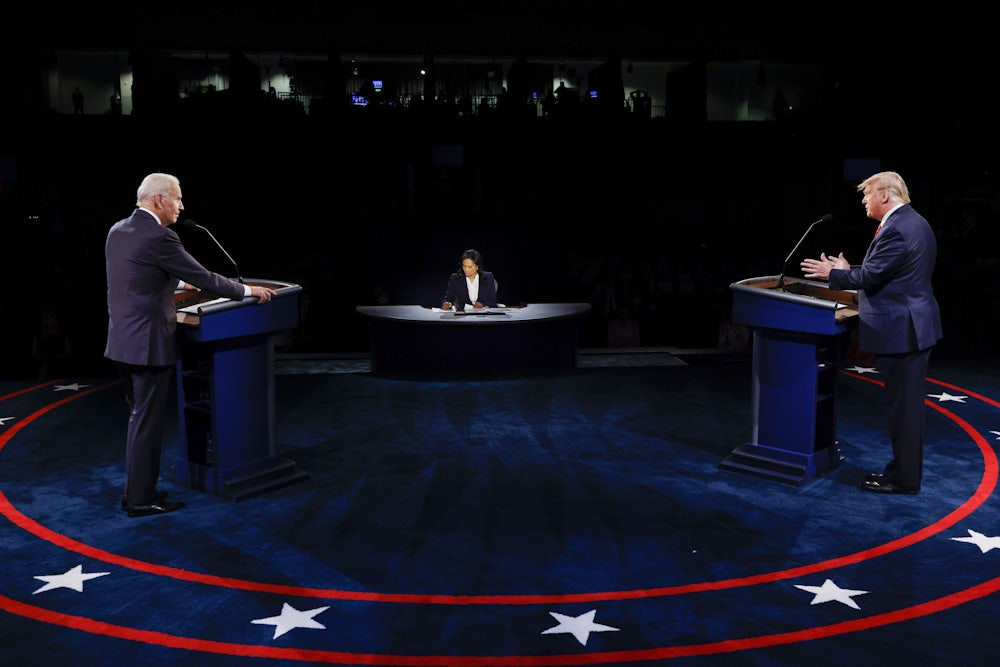Now that the midterms have quieted the doomsters, it is time for Democrats and genuine never-Trump Republicans to dream big. The goal for 2024—whether or not Joe Biden runs—should be a landslide victory for the supporters of democracy, tolerance, and an effective government.
At first glance, though, the idea seems ludicrous. American politics has been balancing on a narrow trapeze wire for the entire twenty-first century. In politics, the very word “landslide” conjures up the era of televisions with rabbit ears and cars with exaggerated tail fins. The last presidential landslide (defined as a popular vote victory of more than 10 percentage points) belonged to Ronald Reagan as he romped to reelection in 1984. Presidential politics have grown so static that the only difference between 2004 (George W. Bush’s reelection) and 2020 (Joe Biden’s triumph) is that five states shifted from the Republicans to the Democrats: Arizona, Colorado, Georgia, Nevada, and Virginia. And the 2020 Democratic margins in Arizona, Georgia, and Nevada combined amounted to just 55,852 votes.
Despite nearly $17 billion spent on the midterms, most of the changes were at the margins. Exactly one Senate seat shifted parties (Democrat John Fetterman replacing retiring Pat Toomey in Pennsylvania) as we await the December 6 Georgia runoff. With only a handful of House races still undecided, Republican potential gains will top out at no more than 10 seats, and most of those came about partially because of redistricting. Gubernatorial contests (with Alaska still outstanding) reflect a similar stasis: Democrats picked up three states (Arizona, Maryland, and Massachusetts) and lost one (Nevada).
If the stakes had not been so high—with election deniers on the ballot and the GOP running as the party of destruction—this would have been seen as a yawner of a midterm. While the Republicans won the House and the right to try to bore the voters to death with overhyped investigations of Hunter Biden’s laptop, the margins in both chambers are so small that votes on Capitol Hill will have to be delayed every time a major airport is snarled by weather during fundraising season. Just a few sudden retirements, party defections, or deaths could swing control of either chamber ahead of the 2024 elections.
The current level of sustained political balance in Congress is unprecedented.
Since the Civil War, there never have been back-to-back congressional elections in which the margins in both the House and the Senate were this tight. The closest parallel came during the George W. Bush years, when neither party had more than 51 votes in the Senate from 2001 to 2005. But thanks to the Republicans gaining House seats in the 2002 election (largely because of the rally-around-the-flag aftermath of the September 11 attacks), House Speaker Denny Hastert possessed more breathing room than Kevin McCarthy (or whoever arises from the coming GOP chaos) will have in January.
Looking at a map of the United States, Democrats might understandably feel anxious. The small-state bias in the Senate (and, as a result, the Electoral College) prompted Mother Jones’s Ari Berman to calculate that 30 Republican senators hail from 15 states whose population collectively is smaller than California with its two Democratic senators. The 2024 Senate map makes these calculations seem even more daunting with Democrats having to defend such ruby-red states as Montana (Jon Tester), Ohio (Sherrod Brown), and West Virginia (Joe Manchin).
Small wonder that smart political commentators assume that the current status quo will continue ad infinitum. Writing for CNN, Ron Brownstein anticipated that the 2024 presidential race (no matter who is on the ballot) will again come down to Arizona, Georgia, Nevada, and Wisconsin. As Brownstein put it, “Each side in an intensely polarized nation of 330 million recognizes that the overall direction of national policy now pivots on the choices of a minuscule number of people living in the tiny patches of contested political ground—white-collar suburbs of Atlanta and Phoenix, working-class Latino neighborhoods in and around Las Vegas and the mid-sized communities of the so-called BOW counties in Wisconsin.”
But that analysis assumes that America—like a stubborn patient in psychotherapy—will never change. States will continue to shift their political allegiance at roughly the pace of continental drift. Yet all through the twentieth century, the political map was torn up on a regular basis. For example, the solid segregationist South, the bulwark of the Democratic Party through the 1950s, became staunchly Republican after the passage of civil rights laws. But even that realignment could be upended by the geographic identity of the Democratic nominee, which explains the victories of former Georgia Governor Jimmy Carter in 1976 and Arkansas Governor Bill Clinton in 1992. Even for the Senate, the political map is not immutable. In 2012, the Democrats won Senate seats in North Dakota, Montana, West Virginia, and Missouri, states that GOP presidential candidate Mitt Romney carried by landslide margins.
Political and polarization are the electoral buzzwords of our era. A March 2022 study of Congress by the Pew Research Center found “that, on average, Democrats and Republicans are farther apart ideologically today than at any time in the past 50 years.” And that was before the House GOP caucus made another lurch to the clown-car right this year as Republican moderates and never-Trumpers were purged in the primaries.
But extreme polarization (or “calcification,” as it’s sometimes called by political scientists) is only part of the problem afflicting democracy. What accentuates the effects of partisan bitterness is that these days every election—for Congress and the White House—is agonizingly close. As political scientists John Sides, Chris Tausanovitch, and Lynn Vavreck write in their study of the 2020 election, The Bitter End, “Increasing partisan polarization has coincided with increasing partisan parity.… This combination of calcification and parity raises the stakes of politics—and makes them more explosive.” Or put another way, the parties have never been further apart, yet because of their rigidity they have been unable to win the permanent allegiance of the dwindling band of persuadable voters.
When a political party goes nutso, as the Republicans have done since Donald Trump descended that escalator in 2015, the American political system used to provide a simple remedy. From 1904 to 1984, there were 13 landslide elections for president. Sometimes it took a few thrashings at the polls, but eventually a political party got the hint from the voters. After losing five straight elections (four of them by double-digit margins), the Republicans under Dwight Eisenhower in the 1950s came to accept the New Deal’s safety net programs, such as Social Security. The overwhelming repudiations of Barry Goldwater (38 percent of the vote in 1964) and George McGovern (also 38 percent in 1972) immediately propelled both parties back to the center. During the 1980s, the Republicans carried 37 states in all three presidential elections. As a result, the downtrodden Democrats successfully triangulated with moderate Bill Clinton in 1992.
We are getting a slight hint of this voter-created transformation as some Republicans are bravely—oh, yes, ever so bravely—publicly acknowledging that maybe Trump is not a stable political genius. Former House Speaker Paul Ryan went out of his way to praise Trump’s accomplishments as president before he mustered the gumption to say on ABC News, “I am a Never-Again Trumper. Why? Because I want to win, and we lose with Trump.” But would-be successors to the Republicans’ leading loser, such as Florida Governor Ron DeSantis, offer the same style of nasty stunt–like politics (abducting Venezuelan asylum-seekers in Texas and shipping them to Martha’s Vineyard) without Trump’s stolen-election narcissism. This tiptoeing away from Trump (even if successful) is not a repudiation but merely a sleight-of-hand rebranding.
Sooner or later, American politics has to move off the knife edge. Democracy will always be in peril if one political party remains beholden to charlatans, conspiracy theorists, and contemptible demagogues. That’s why the only effective permanent purge of Trumpism will come with an old-fashioned twentieth-century landslide election in 2024. Maybe it’s an unattainable goal given the current political cleavages. But with an ambitious Biden agenda stymied for the next two years by a Republican House out of order, the most realistic strategy lies in trying to forge a lasting center-left majority. Not only would it create a governing majority for 2025 and beyond, but it may also save the Republican Party in the process.






